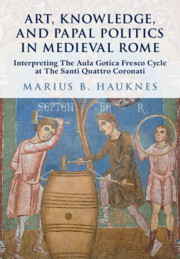 Art, Knowledge, and Papal Politics in Medieval Rome
Art, Knowledge, and Papal Politics in Medieval Rome The Liberal Arts at Santi Quattro Coronati
Published online by Cambridge University Press: 30 January 2025
Visitors to Cardinal Conti’s great hall would enter through the principal doorway in the south bay and find themselves greeted by the figure of King Solomon, who stands, flanked by two small windows, at the center of the north wall (see Figure 1.1). Dressed in the manner of an ancient emperor and accompanied by an army of triumphant virtues, Solomon stands as a symbol of justice and wise rulership. It is possible that Stefano Conti’s throne was placed directly beneath the biblical ruler. If so, the cardinal would have sat as a self-fashioned heir to Solomon’s wisdom and jurisprudence, and as a viewer of his newly commissioned fresco cycle. From his position at the north end of the hall, Conti would look toward the south bay, whose pictorial decorations are conceived as a model of the cosmos. The south bay vault, under which his visitors would be standing, features a vast celestial diagram with the twelve signs of the zodiac and other mythologically significant constellations from the northern hemisphere. In the spandrels of the vault are personifications of the four seasons depicted as men of increasing age, each surrounded by the winds rendered as winged heads with puffed cheeks. The four seasons serve to connect the vault fresco – both physically and thematically – to the calendar cycle on the walls below. The calendar represents the twelve months as scenes of agricultural activity: grain threshing, seed sowing, grape treading, livestock butchering, and so forth. Situated between these images of cosmic temporality, in the three lunettes, are representations of five liberal arts: grammar, geometry, music, arithmetic, and astronomy. This sequence of liberal disciplines, the only such surviving cycle in medieval Roman art, visualizes the educational curriculum through a combination of personifications, historical figures, inscriptions, and technological instruments (see Figures 1.2–1.4). Seen in relation to the surrounding imagery, the liberal arts cycle situates the intellectual pursuits of the nobility in contrast with the manual labor performed by the peasantry in the agricultural calendar. The artes liberales also establish an important thematic link to the frescoes in the north bay. The clerestory level in the north bay features a remarkably complex cycle of virtues and vices that combines allegorical figures with historical characters. The historical characters in the virtues cycle – a diverse selection of saints and sinners drawn from ecclesiastical history – serve as exempla of the virtuous and vicious qualities with which they are paired. Similarly, each image in the arts sequence features a historical character that was meant to be understood as the ancient progenitor of the discipline in question. Finally, in their emphasis on intellectual heritage from antiquity, the scientific progenitors in the arts cycle also complement the images in the north bay lunettes, where representations of Roman antiquities foreground the material and iconographic inheritance from the ancient world.
To save this book to your Kindle, first ensure no-reply@cambridge.org is added to your Approved Personal Document E-mail List under your Personal Document Settings on the Manage Your Content and Devices page of your Amazon account. Then enter the ‘name’ part of your Kindle email address below. Find out more about saving to your Kindle.
Note you can select to save to either the @free.kindle.com or @kindle.com variations. ‘@free.kindle.com’ emails are free but can only be saved to your device when it is connected to wi-fi. ‘@kindle.com’ emails can be delivered even when you are not connected to wi-fi, but note that service fees apply.
Find out more about the Kindle Personal Document Service.
To save content items to your account, please confirm that you agree to abide by our usage policies. If this is the first time you use this feature, you will be asked to authorise Cambridge Core to connect with your account. Find out more about saving content to Dropbox.
To save content items to your account, please confirm that you agree to abide by our usage policies. If this is the first time you use this feature, you will be asked to authorise Cambridge Core to connect with your account. Find out more about saving content to Google Drive.